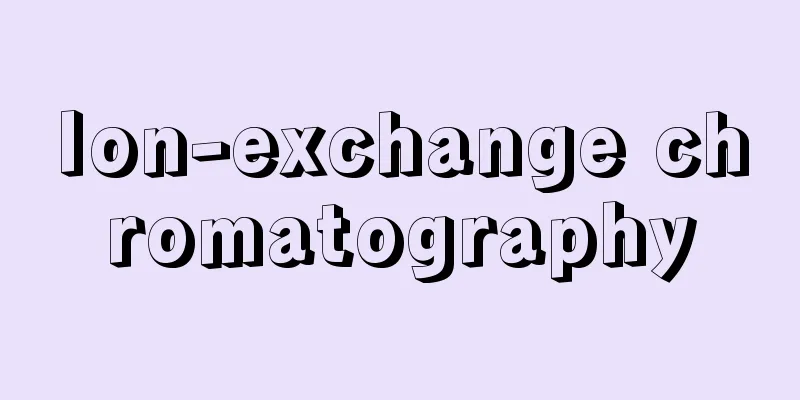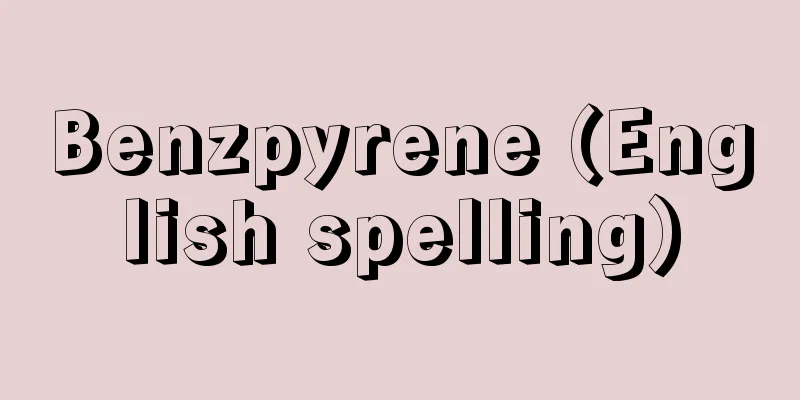Ion-exchange chromatography

|
A method of separating and quantifying target components in a sample solution using ion exchange resin or other ion exchangers as the stationary phase (adsorbent). It is a type of liquid chromatography. In general, the sample solution is placed at the top of a column packed with ion exchange resin, and then an appropriate electrolyte solution is developed as the mobile phase. The ions are selectively captured and separated due to the difference in affinity (ion exchange capacity) of the component ions to the resin, and are eluted from the bottom of the column. Cation exchange resins are used to separate cations, and anion exchange resins are used to separate anions. Ion exchange resins have a large exchange capacity, and various types of ion exchange resins and electrolyte solutions used as the mobile phase can be changed. The separation factor can also be increased by changing the hydrogen ion concentration (pH), ionic strength, and complex formation ability of the solution, making it possible to separate and quantify electrolytes that are difficult to separate by other methods. Historically, it has been used to separate fission products and transuranium elements, making a great contribution to the separation and identification of new elements. Since the equipment can be easily made and used repeatedly, it is one of the most widely used separation and quantification methods not only in laboratories but also in industry. A special ion exchanger with a small ion exchange capacity of 0.01 to 0.1 meg/g, mechanical strength that can withstand high pressure, little contraction or expansion, and can be used with a fairly wide range of solutions of pH is used, and elution development is made quick by applying pressure with a constant flow pressure pump. Basically, it is the same as in high performance liquid chromatography, and consists of an eluent reservoir, a pump, a sample injector, a separation column, a detector, and an eluent reservoir. This equipment is called an ion chromatograph, and this method is called ion chromatography (IC). Detectors include electrical conductivity detectors, ultraviolet/visible absorbance detectors, fluorescence detectors, and electrochemical detectors, but electrical conductivity detectors are often used because of their high sensitivity, excellent response and linearity, and general purpose. In this case, the electrical conductivity of the electrolyte solution itself, which is the eluent, is high, making it extremely difficult to detect minute changes in the electrical conductivity of the ions to be measured. For this purpose, a background reduction device (suppressor) is used between the column and the detector, or an eluent with low electrical conductivity such as an organic acid buffer is used. The former is called the suppressed method, and the latter is called the non-suppressed method. Ion chromatography is an effective method for separating and analyzing most inorganic cations, inorganic anions, organic acids, and other ions, and has features such as the ability to simultaneously measure multiple ions with a small amount of sample, little interference from coexisting substances, high sensitivity, and ease of automation. For these reasons, it has been adopted as an official method by the EPA (U.S. Environmental Protection Agency), JIS (Japanese Industrial Standards), ISO (International Organization for Standardization), and others. [Takada Takeo] "Analytical Chemistry Lectures: Ion Exchange Methods" (1957, Kyoritsu Publishing), edited by the Japan Society for Analytical Chemistry, written by Yukichi Yoshino and Masatoshi Fujimoto" ▽ "Instrumental Analysis Practical Series: Ion Chromatography" (1988, Kyoritsu Publishing), edited by the Japan Society for Analytical Chemistry, written by Yoshikazu Muto et al. ▽ "Fundamentals of Analytical Chemistry" (1994, Kyoritsu Publishing), written by Masatada Satake, Yoshiyuki Mido and Toru Nagahiro" [Reference] | | | | |Source: Shogakukan Encyclopedia Nipponica About Encyclopedia Nipponica Information | Legend |
|
イオン交換樹脂その他のイオン交換体を固定相(吸着剤)として試料溶液中の目的成分を分離・定量する方法で、液体クロマトグラフィーの一つ。一般には、イオン交換樹脂を詰めたカラム(管柱)の上端に試料液を入れ、ついで適当な電解質溶液を移動相として展開すると、成分イオンの樹脂に対する親和力(イオン交換能)の差によってイオンが選択的に捕捉され、分離されてカラムの下端から順に溶出する。陽イオンの分離には陽イオン交換樹脂が、陰イオンの分離には陰イオン交換樹脂が使われる。イオン交換樹脂は交換容量が大きく、またその種類や、移動相として用いる電解質溶液の種類がいろいろ変えられ、溶液の水素イオン濃度指数(pH)、イオン強度、錯体の生成能などの変化によっても分離係数を大きくすることができ、他の方法では分離が困難な電解質の分離・定量が可能である。歴史的にも、核分裂生成物の分離に威力を発揮し、また超ウラン元素の分離に用いられ、新元素の分離、確認に大きな貢献があった。装置を簡単に自作でき、反復して使用できるので、実験室のみならず工業的にももっとも広く利用されている分離・定量法の一つである。イオン交換体としてイオン交換容量が0.01~0.1meg/gと小さく、高圧に耐えうる機械的強度をもち、収縮や膨張が少なく、pHのかなり広範囲の溶液で使用できるような特殊なものを用い、定流量加圧送液ポンプで加圧により溶離展開を迅速にする方法がある。基本的には高速液体クロマトグラフィーの場合と同じで、溶離液貯留槽、ポンプ、試料注入器、分離カラム、検出器、溶出液貯留槽で構成されている。この装置をイオンクロマトグラフ、またこの方法をイオンクロマトグラフィー(IC)という。検出器には、電気伝導度検出器、紫外・可視吸光光度検出器、蛍光光度検出器、電気化学的検出器などがあるが、感度が高く、応答性や直線性に優れ、汎用(はんよう)性のある電気伝導度検出器を用いることが多い。この場合、溶離液である電解質溶液自身の電気伝導率が大きく、測定イオンの電気伝導率の微少変化を検出することがきわめて困難である。そのためのバックグラウンド減少装置(サプレッサー)をカラムと検出器の間に用いるか、有機酸系緩衝液などの低電気伝導率の溶離液を用いるなどの方法がとられている。前者をサプレスト式、後者をノンサプレスト式という。イオンクロマトグラフィーは、ほとんどの無機陽イオン、無機陰イオン、有機酸、その他のイオンの分離分析に有効な方法であり、少量の試料で複数のイオンを同時に測定でき、共存物質の干渉も少なく、高感度で自動化が容易であるなどの特徴をもっている。このため、EPA(アメリカ環境保護庁)、JIS(ジス)(日本工業規格)、ISO(国際標準化機構)などで公定法として採用されている。 [高田健夫] 『日本分析化学会編、吉野諭吉・藤本昌利著『分析化学講座 イオン交換法』(1957・共立出版)』▽『日本分析化学会編、武藤義一他著『機器分析実技シリーズ イオンクロマトグラフィー』(1988・共立出版)』▽『佐竹正忠・御堂義之・永広徹著『分析化学の基礎』(1994・共立出版)』 [参照項目] | | | | |出典 小学館 日本大百科全書(ニッポニカ)日本大百科全書(ニッポニカ)について 情報 | 凡例 |
Recommend
Rickets (Kurbyō)
Vitamin D deficiency seen in children (in adults, ...
Wutitz, E.
…On the other hand, Max Dessoir (1867-1947) empha...
Kashiwa
Another name for chicken. Originally, chickens wi...
Freddie, W. (English spelling) FreddieW
...In the 1930s, bases were established in Easter...
Nihilism - Nihilismus (English spelling) German
It is translated as "nihilism." Accordi...
Streptopus simplex (English spelling)
…[Tetsuichi Yahara]. … *Some of the terminology t...
Representative Director - Daihyotorishimariyaku
In companies other than those with a committee sy...
Standard money - honikahei (English spelling) standard money English
A coin containing a legally determined gold (silv...
Cuernavaca (English spelling)
The capital of the state of Morelos in central Mex...
Fuyou Wakashu - Collection of poems by Fuyou Wakashu
This is a collection of narrative poems compiled ...
Light dispersion - Hikaribunsan
When a thin, parallel beam of white light is incid...
Impression - Shinsho
It refers to the conviction that a judge has afte...
Reinforcement - Kyouka (English spelling)
Reinforcement refers to the presentation of a posi...
Toyoda Shiro
Film director. Born in Kyoto City. After graduati...
Ballila
…The form of the group varies according to the pu...









